Target Information
| Target General Information | Top | |||||
|---|---|---|---|---|---|---|
| Target ID |
T42392
(Former ID: TTDI01970)
|
|||||
| Target Name |
Glutamate receptor AMPA 2 (GRIA2)
|
|||||
| Synonyms |
Glutamate receptor ionotropic, AMPA 2; Glutamate receptor 2; GluRK2; GluRB; GluR2; GluR-K2; GluR-B; GluR-2; GluA2; AMPAselective glutamate receptor 2; AMPA-selective glutamate receptor 2
Click to Show/Hide
|
|||||
| Gene Name |
GRIA2
|
|||||
| Target Type |
Successful target
|
[1] | ||||
| Disease | [+] 1 Target-related Diseases | + | ||||
| 1 | Neuropathy [ICD-11: 8C0Z] | |||||
| Function |
L-glutamate acts as an excitatory neurotransmitter at many synapses in the central nervous system. Binding of the excitatory neurotransmitter L-glutamate induces a conformation change, leading to the opening of the cation channel, and thereby converts the chemical signal to an electrical impulse. The receptor then desensitizes rapidly and enters a transient inactive state, characterized by the presence of bound agonist. In the presence of CACNG4 or CACNG7 or CACNG8, shows resensitization which is characterized by a delayed accumulation of current flux upon continued application of glutamate. Through complex formation with NSG1, GRIP1 and STX12 controls the intracellular fate of AMPAR and the endosomal sorting of the GRIA2 subunit toward recycling and membrane targeting. Receptor for glutamate that functions as ligand-gated ion channel in the central nervous system and plays an important role in excitatory synaptic transmission.
Click to Show/Hide
|
|||||
| BioChemical Class |
Glutamate-gated ion channel
|
|||||
| UniProt ID | ||||||
| Sequence |
MQKIMHISVLLSPVLWGLIFGVSSNSIQIGGLFPRGADQEYSAFRVGMVQFSTSEFRLTP
HIDNLEVANSFAVTNAFCSQFSRGVYAIFGFYDKKSVNTITSFCGTLHVSFITPSFPTDG THPFVIQMRPDLKGALLSLIEYYQWDKFAYLYDSDRGLSTLQAVLDSAAEKKWQVTAINV GNINNDKKDEMYRSLFQDLELKKERRVILDCERDKVNDIVDQVITIGKHVKGYHYIIANL GFTDGDLLKIQFGGANVSGFQIVDYDDSLVSKFIERWSTLEEKEYPGAHTTTIKYTSALT YDAVQVMTEAFRNLRKQRIEISRRGNAGDCLANPAVPWGQGVEIERALKQVQVEGLSGNI KFDQNGKRINYTINIMELKTNGPRKIGYWSEVDKMVVTLTELPSGNDTSGLENKTVVVTT ILESPYVMMKKNHEMLEGNERYEGYCVDLAAEIAKHCGFKYKLTIVGDGKYGARDADTKI WNGMVGELVYGKADIAIAPLTITLVREEVIDFSKPFMSLGISIMIKKPQKSKPGVFSFLD PLAYEIWMCIVFAYIGVSVVLFLVSRFSPYEWHTEEFEDGRETQSSESTNEFGIFNSLWF SLGAFMQQGCDISPRSLSGRIVGGVWWFFTLIIISSYTANLAAFLTVERMVSPIESAEDL SKQTEIAYGTLDSGSTKEFFRRSKIAVFDKMWTYMRSAEPSVFVRTTAEGVARVRKSKGK YAYLLESTMNEYIEQRKPCDTMKVGGNLDSKGYGIATPKGSSLRNAVNLAVLKLNEQGLL DKLKNKWWYDKGECGSGGGDSKEKTSALSLSNVAGVFYILVGGLGLAMLVALIEFCYKSR AEAKRMKVAKNAQNINPSSSQNSQNFATYKEGYNVYGIESVKI Click to Show/Hide
|
|||||
| 3D Structure | Click to Show 3D Structure of This Target | AlphaFold | ||||
| HIT2.0 ID | T14JBS | |||||
| Drugs and Modes of Action | Top | |||||
|---|---|---|---|---|---|---|
| Clinical Trial Drug(s) | [+] 1 Clinical Trial Drugs | + | ||||
| 1 | Paliroden | Drug Info | Phase 2 | Parkinson disease | [4] | |
| Mode of Action | [+] 3 Modes of Action | + | ||||
| Modulator | [+] 1 Modulator drugs | + | ||||
| 1 | Paliroden | Drug Info | [5] | |||
| Agonist | [+] 2 Agonist drugs | + | ||||
| 1 | (S)-5-fluorowillardiine | Drug Info | [6] | |||
| 2 | [3H]AMPA | Drug Info | [6] | |||
| Antagonist | [+] 2 Antagonist drugs | + | ||||
| 1 | ATPO | Drug Info | [6] | |||
| 2 | [3H]CNQX | Drug Info | [6] | |||
| Cell-based Target Expression Variations | Top | |||||
|---|---|---|---|---|---|---|
| Cell-based Target Expression Variations | ||||||
| Drug Binding Sites of Target | Top | |||||
|---|---|---|---|---|---|---|
| Ligand Name: TAK-653 | Ligand Info | |||||
| Structure Description | Crystal structure of the GluA2o LBD in complex with glutamate and TAK-653 | PDB:7F3O | ||||
| Method | X-ray diffraction | Resolution | 1.44 Å | Mutation | No | [7] |
| PDB Sequence |
GSNKTVVVTT
420 ILESPYVMMK430 KNHEMLEGNE440 RYEGYCVDLA450 AEIAKHCGFK460 YKLTIVGDGK 470 YGARDADTKI480 WNGMVGELVY490 GKADIAIAPL500 TITLVREEVI510 DFSKPFMSLG 520 ISIMIKKGTP653 IESAEDLSKQ663 TEIAYGTLDS673 GSTKEFFRRS683 KIAVFDKMWT 693 YMRSAEPSVF703 VRTTAEGVAR713 VRKSKGKYAY723 LLESTMNEYI733 EQRKPCDTMK 743 VGGNLDSKGY753 GIATPKGSSL763 RNAVNLAVLK773 LNEQGLLDKL783 KNKWWYDKGE 793 CG
|
|||||
|
|
||||||
| Ligand Name: Mibampator | Ligand Info | |||||
| Structure Description | Crystal structure of the GluA2o LBD in complex with glutamate and LY451395 | PDB:5YBG | ||||
| Method | X-ray diffraction | Resolution | 1.52 Å | Mutation | No | [8] |
| PDB Sequence |
NKTVVVTTIL
422 ESPYVMMKKN432 HEMLEGNERY442 EGYCVDLAAE452 IAKHCGFKYK462 LTIVGDGKYG 472 ARDADTKIWN482 GMVGELVYGK492 ADIAIAPLTI502 TLVREEVIDF512 SKPFMSLGIS 522 IMIKKGTPIE655 SAEDLSKQTE665 IAYGTLDSGS675 TKEFFRRSKI685 AVFDKMWTYM 695 RSAEPSVFVR705 TTAEGVARVR715 KSKGKYAYLL725 ESTMNEYIEQ735 RKPCDTMKVG 745 GNLDSKGYGI755 ATPKGSSLRN765 AVNLAVLKLN775 EQGLLDKLKN785 KWWYDKGECG 795
|
|||||
|
|
||||||
| Click to View More Binding Site Information of This Target with Different Ligands | ||||||
| Different Human System Profiles of Target | Top |
|---|---|
|
Human Similarity Proteins
of target is determined by comparing the sequence similarity of all human proteins with the target based on BLAST. The similarity proteins for a target are defined as the proteins with E-value < 0.005 and outside the protein families of the target.
A target that has fewer human similarity proteins outside its family is commonly regarded to possess a greater capacity to avoid undesired interactions and thus increase the possibility of finding successful drugs
(Brief Bioinform, 21: 649-662, 2020).
Human Tissue Distribution
of target is determined from a proteomics study that quantified more than 12,000 genes across 32 normal human tissues. Tissue Specificity (TS) score was used to define the enrichment of target across tissues.
The distribution of targets among different tissues or organs need to be taken into consideration when assessing the target druggability, as it is generally accepted that the wider the target distribution, the greater the concern over potential adverse effects
(Nat Rev Drug Discov, 20: 64-81, 2021).
Human Pathway Affiliation
of target is determined by the life-essential pathways provided on KEGG database. The target-affiliated pathways were defined based on the following two criteria (a) the pathways of the studied target should be life-essential for both healthy individuals and patients, and (b) the studied target should occupy an upstream position in the pathways and therefore had the ability to regulate biological function.
Targets involved in a fewer pathways have greater likelihood to be successfully developed, while those associated with more human pathways increase the chance of undesirable interferences with other human processes
(Pharmacol Rev, 58: 259-279, 2006).
Biological Network Descriptors
of target is determined based on a human protein-protein interactions (PPI) network consisting of 9,309 proteins and 52,713 PPIs, which were with a high confidence score of ≥ 0.95 collected from STRING database.
The network properties of targets based on protein-protein interactions (PPIs) have been widely adopted for the assessment of target’s druggability. Proteins with high node degree tend to have a high impact on network function through multiple interactions, while proteins with high betweenness centrality are regarded to be central for communication in interaction networks and regulate the flow of signaling information
(Front Pharmacol, 9, 1245, 2018;
Curr Opin Struct Biol. 44:134-142, 2017).
Human Similarity Proteins
Human Tissue Distribution
Human Pathway Affiliation
Biological Network Descriptors
|
|
|
There is no similarity protein (E value < 0.005) for this target
|
|
Note:
If a protein has TS (tissue specficity) scores at least in one tissue >= 2.5, this protein is called tissue-enriched (including tissue-enriched-but-not-specific and tissue-specific). In the plots, the vertical lines are at thresholds 2.5 and 4.
|
| KEGG Pathway | Pathway ID | Affiliated Target | Pathway Map |
|---|---|---|---|
| cAMP signaling pathway | hsa04024 | Affiliated Target |

|
| Class: Environmental Information Processing => Signal transduction | Pathway Hierarchy | ||
| Neuroactive ligand-receptor interaction | hsa04080 | Affiliated Target |
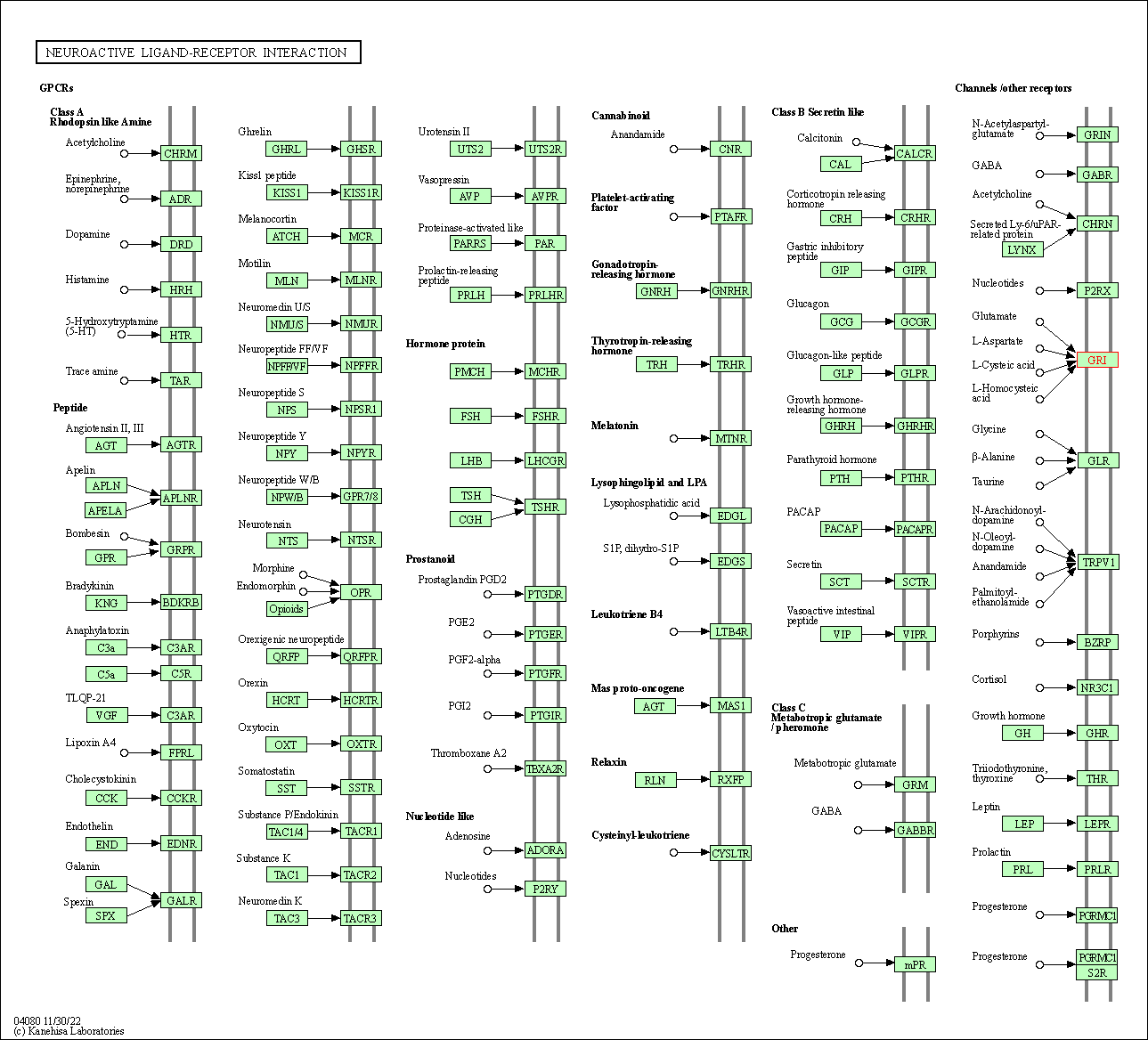
|
| Class: Environmental Information Processing => Signaling molecules and interaction | Pathway Hierarchy | ||
| Circadian entrainment | hsa04713 | Affiliated Target |

|
| Class: Organismal Systems => Environmental adaptation | Pathway Hierarchy | ||
| Long-term potentiation | hsa04720 | Affiliated Target |
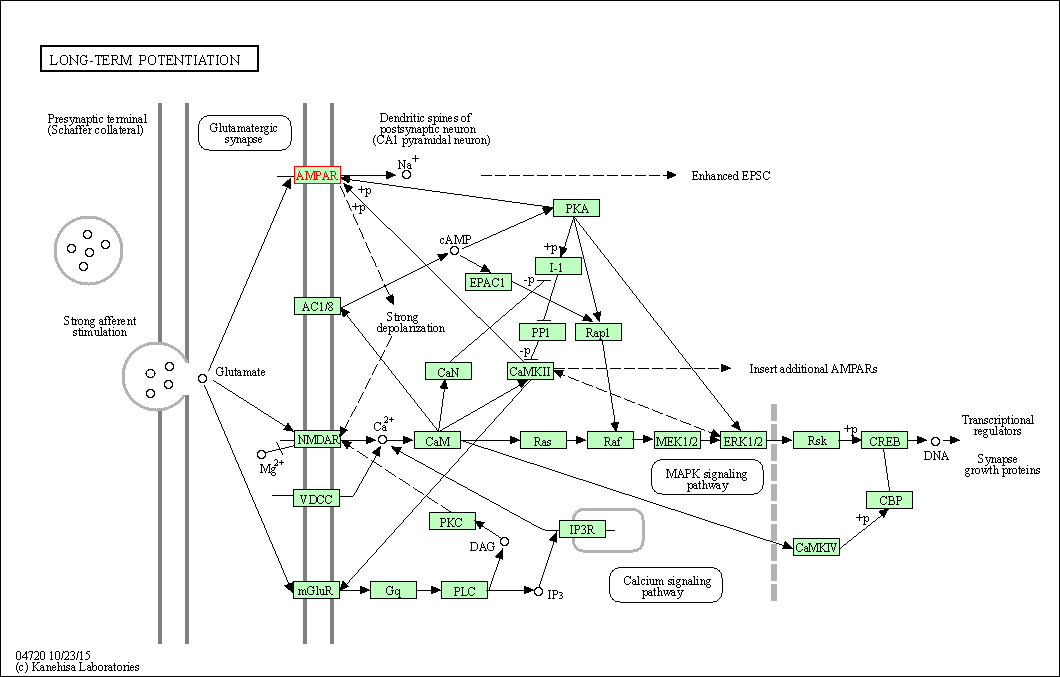
|
| Class: Organismal Systems => Nervous system | Pathway Hierarchy | ||
| Retrograde endocannabinoid signaling | hsa04723 | Affiliated Target |
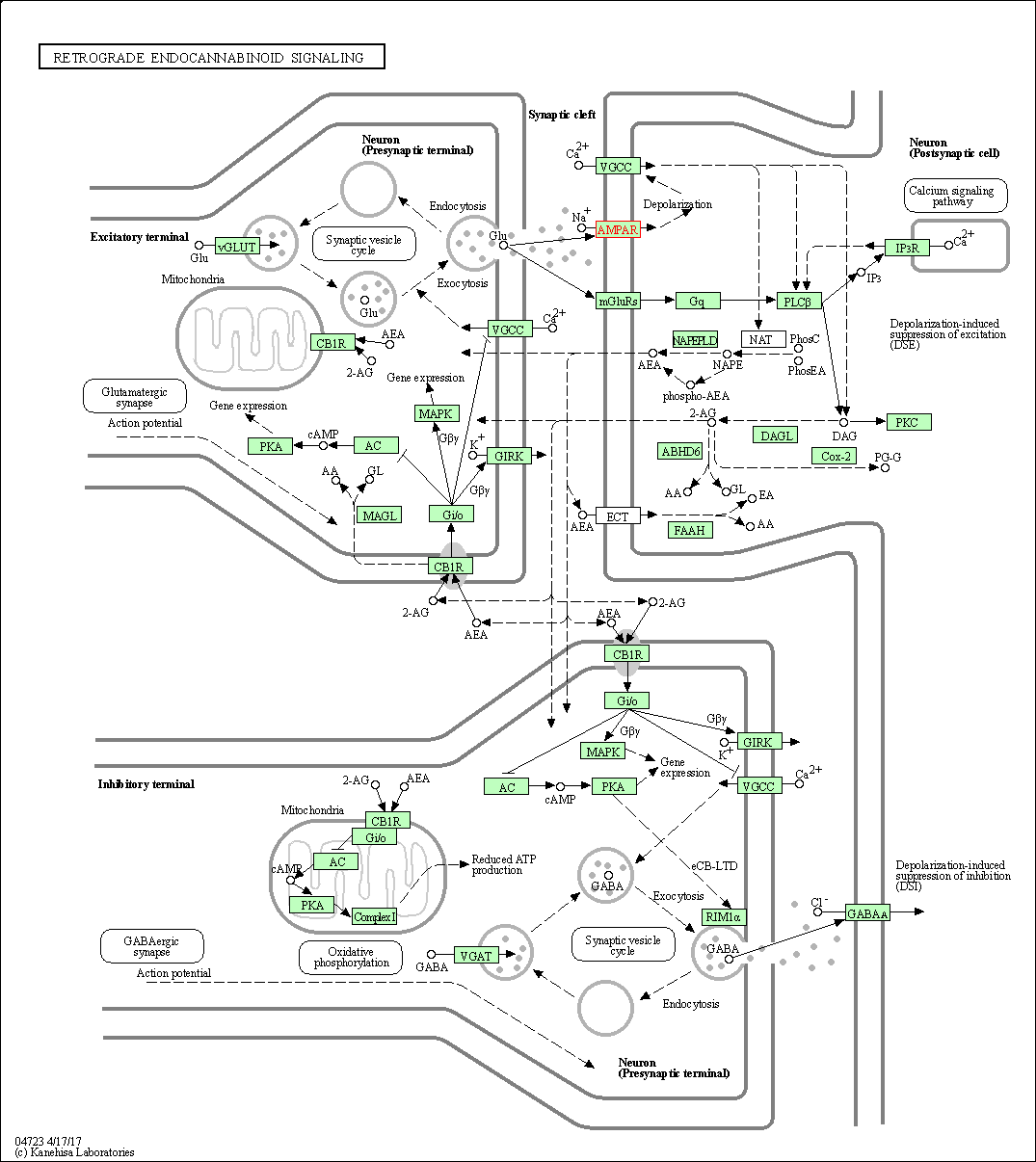
|
| Class: Organismal Systems => Nervous system | Pathway Hierarchy | ||
| Glutamatergic synapse | hsa04724 | Affiliated Target |
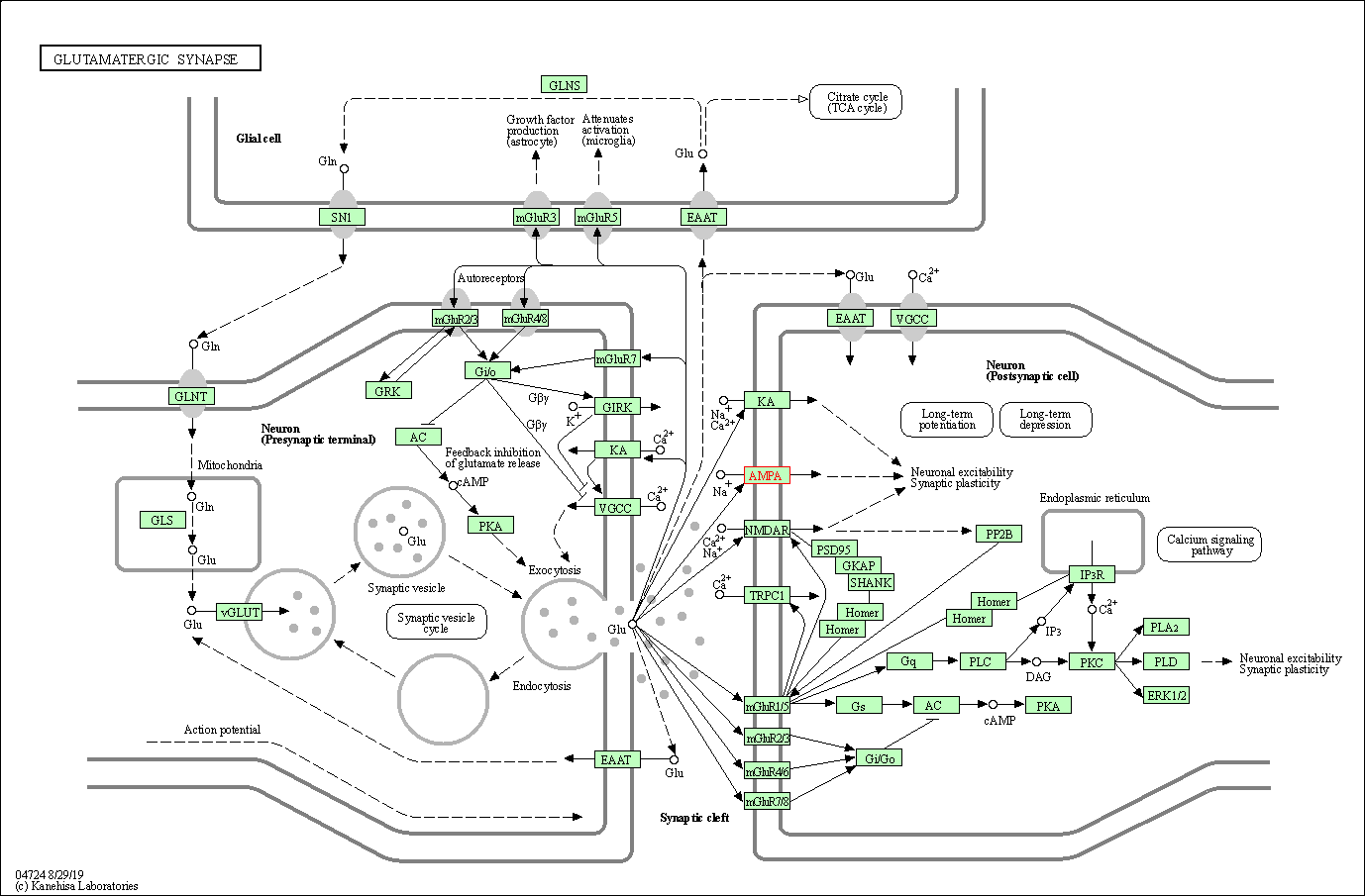
|
| Class: Organismal Systems => Nervous system | Pathway Hierarchy | ||
| Dopaminergic synapse | hsa04728 | Affiliated Target |
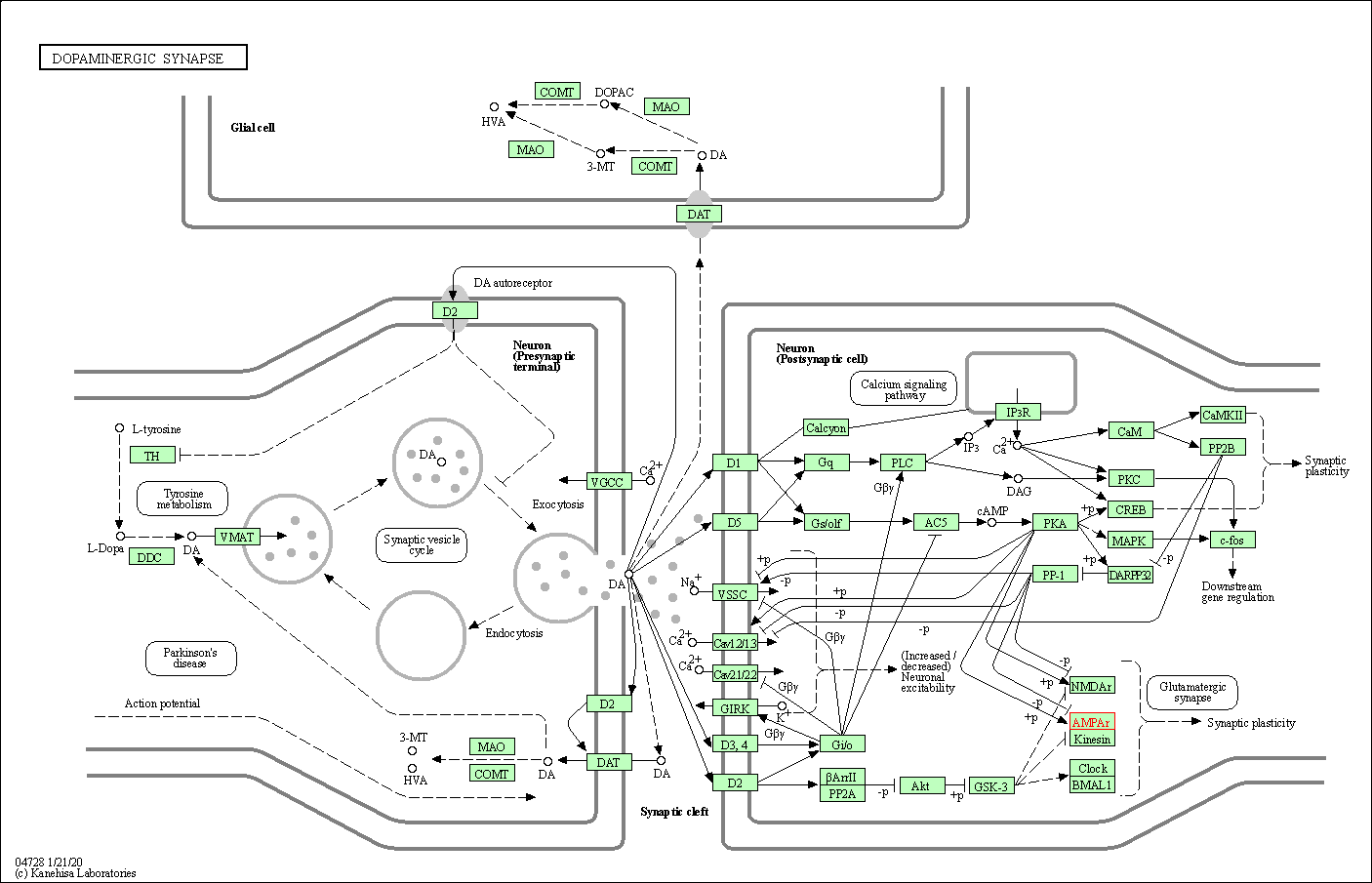
|
| Class: Organismal Systems => Nervous system | Pathway Hierarchy | ||
| Long-term depression | hsa04730 | Affiliated Target |

|
| Class: Organismal Systems => Nervous system | Pathway Hierarchy | ||
| Click to Show/Hide the Information of Affiliated Human Pathways | |||
| Degree | 22 | Degree centrality | 2.36E-03 | Betweenness centrality | 9.21E-04 |
|---|---|---|---|---|---|
| Closeness centrality | 2.19E-01 | Radiality | 1.38E+01 | Clustering coefficient | 2.16E-01 |
| Neighborhood connectivity | 1.47E+01 | Topological coefficient | 8.26E-02 | Eccentricity | 12 |
| Download | Click to Download the Full PPI Network of This Target | ||||
| Chemical Structure based Activity Landscape of Target | Top |
|---|---|
| Drug Property Profile of Target | Top | |
|---|---|---|
| (1) Molecular Weight (mw) based Drug Clustering | (2) Octanol/Water Partition Coefficient (xlogp) based Drug Clustering | |
|
|
||
| (3) Hydrogen Bond Donor Count (hbonddonor) based Drug Clustering | (4) Hydrogen Bond Acceptor Count (hbondacc) based Drug Clustering | |
|
|
||
| (5) Rotatable Bond Count (rotbonds) based Drug Clustering | (6) Topological Polar Surface Area (polararea) based Drug Clustering | |
|
|
||
| "RO5" indicates the cutoff set by lipinski's rule of five; "D123AB" colored in GREEN denotes the no violation of any cutoff in lipinski's rule of five; "D123AB" colored in PURPLE refers to the violation of only one cutoff in lipinski's rule of five; "D123AB" colored in BLACK represents the violation of more than one cutoffs in lipinski's rule of five | ||
| Co-Targets | Top | |||||
|---|---|---|---|---|---|---|
| Co-Targets | ||||||
| Target Poor or Non Binders | Top | |||||
|---|---|---|---|---|---|---|
| Target Poor or Non Binders | ||||||
| Target Regulators | Top | |||||
|---|---|---|---|---|---|---|
| Target-regulating microRNAs | ||||||
| Target-interacting Proteins | ||||||
| Target Profiles in Patients | Top | |||||
|---|---|---|---|---|---|---|
| Target Expression Profile (TEP) | ||||||
| Target Affiliated Biological Pathways | Top | |||||
|---|---|---|---|---|---|---|
| NetPath Pathway | [+] 1 NetPath Pathways | + | ||||
| 1 | IL2 Signaling Pathway | |||||
| Panther Pathway | [+] 2 Panther Pathways | + | ||||
| 1 | Ionotropic glutamate receptor pathway | |||||
| 2 | Metabotropic glutamate receptor group III pathway | |||||
| PID Pathway | [+] 1 PID Pathways | + | ||||
| 1 | N-cadherin signaling events | |||||
| References | Top | |||||
|---|---|---|---|---|---|---|
| REF 1 | Antibodies and venom peptides: new modalities for ion channels. Nat Rev Drug Discov. 2019 May;18(5):339-357. | |||||
| REF 2 | URL: http://www.guidetopharmacology.org Nucleic Acids Res. 2015 Oct 12. pii: gkv1037. The IUPHAR/BPS Guide to PHARMACOLOGY in 2016: towards curated quantitative interactions between 1300 protein targets and 6000 ligands. (Ligand id: 7050). | |||||
| REF 3 | Nat Rev Drug Discov. 2013 Feb;12(2):87-90. | |||||
| REF 4 | ClinicalTrials.gov (NCT00285025) Study of the Effect of SR57667B in Patients With Alzheimer's Disease. U.S. National Institutes of Health. | |||||
| REF 5 | Mechanism of inhibition of the GluA2 AMPA receptor channel opening by talampanel and its enantiomer: the stereochemistry of the 4-methyl group on the diazepine ring of 2,3-benzodiazepine derivatives.ACS Chem Neurosci.2013 Apr 17;4(4):635-44. | |||||
| REF 6 | URL: http://www.guidetopharmacology.org Nucleic Acids Res. 2015 Oct 12. pii: gkv1037. The IUPHAR/BPS Guide to PHARMACOLOGY in 2016: towards curated quantitative interactions between 1300 protein targets and 6000 ligands. (Target id: 445). | |||||
| REF 7 | Strictly regulated agonist-dependent activation of AMPA-R is the key characteristic of TAK-653 for robust synaptic responses and cognitive improvement. Sci Rep. 2021 Jul 15;11(1):14532. | |||||
| REF 8 | HBT1, a Novel AMPA Receptor Potentiator with Lower Agonistic Effect, Avoided Bell-Shaped Response in In Vitro BDNF Production. J Pharmacol Exp Ther. 2018 Mar;364(3):377-389. | |||||
If You Find Any Error in Data or Bug in Web Service, Please Kindly Report It to Dr. Zhou and Dr. Zhang.

